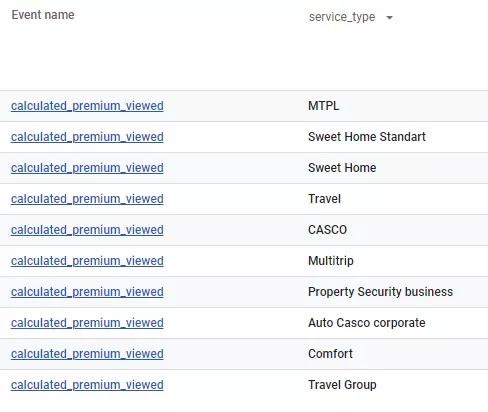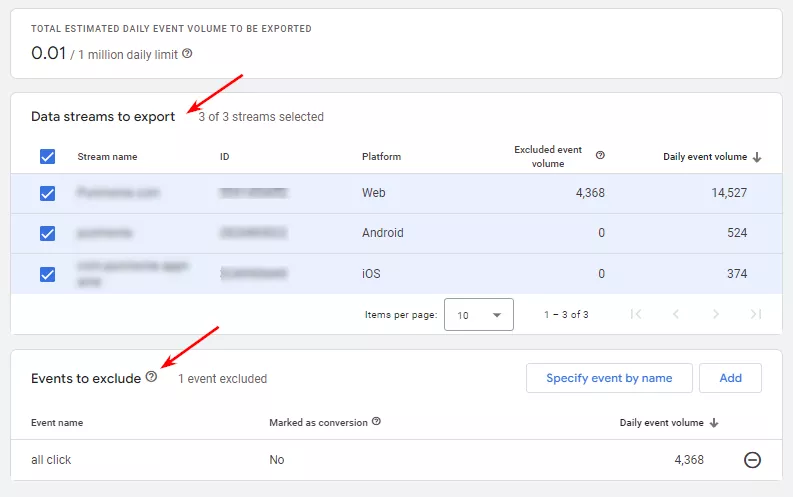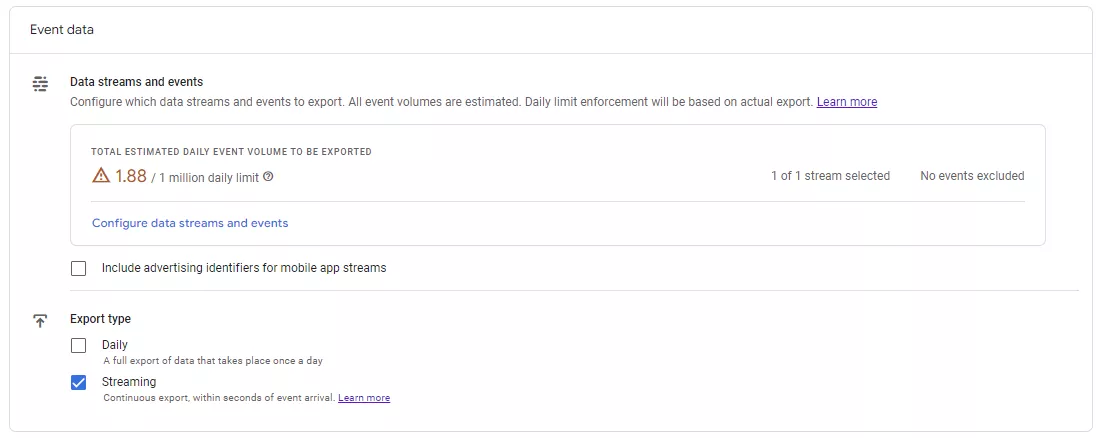How to Bypass the One Million Limit on Events Export from Google Analytics 4 to Google BigQuery
Marketers can get valuable insights by exporting raw data from Google Analytics 4 to Google BigQuery. Analyzing and combining this data with other marketing and internal systems will help you make accurate decisions and prompt adjustments to your development strategy.
However, there is a catch: you can only upload one million events per day. This limits the amount of data that can be exported to BigQuery and complicates the data analysis and decision-making process.
In this article, I will show you how to overcome this one million limit and export more events from GA4 to BigQuery.
Synergy between Google BigQuery and GA4
With the closure of Universal Analytics, two important tools are gaining popularity: Google BigQuery and Google Analytics 4 (GA4).
Learn how to make a timely transition to Google Analytics 4.
- Google BigQuery is the best platform for marketing analytics. It easily integrates with GA4, allowing you to store data from different platforms and see the big picture of your business.
- Google BigQuery protects data by controlling access to it. It is also scalable and flexible without the need for large resources.
- You can export all raw events from the GA4 resource to BigQuery. Then, use SQL-like syntax to query and manipulate this data.
- Data integration is free, but there is a fee for data storage. See Google Help for pricing.
- Thanks to the combination of the two tools, you don't have to worry about data sampling in Google Analytics 4. Once you send raw data to BigQuery, you will have everything you need for analysis.
Despite these advantages, unfortunately, the default resources have a daily BigQuery export limit of one million events:
However, there are certain ways around this one-million limit. Let me give you some tips on how to overcome this limit.
1. Optimize events
First, organize events in your analytics more efficiently.
Carefully consider the user actions on your website or app, and identify those that are useful to measure. Make sure that the structure is thought out optimally. This will allow you to export fewer events without losing valuable data.
Remove duplicate events
Before exporting, it is important to check the GA4 settings for duplicate events. Removing duplicates will help you avoid excessive and unnecessary data.
Use event parameters
Setting parameters will help you combine similar events and limit the total number of exported events. This is because parameters are not counted as separate events.
For example, in this case, instead of creating a separate event for each service, we created a calculated_premium_viewed event with the service_type parameter:
Avoid adding noisy events
Check for noisy events that can skew analytics data due to excessive volume or incorrect data collection. For example, misconfigured triggers or events that unnecessarily track every click.
2. Exclude events or streams from export
This can be useful if some events are not important for your analysis.
3. Use streaming export
This method provides faster access to data in BigQuery. The information is sent instantly, allowing you to analyze relevant information in real-time. It also allows you to send more than one million events per day.
The number of events for streaming export is unlimited.
Note: There may be an additional charge for using streaming export, typically $0.05 per GB.
4. Use separate properties
Track different parts of your site with separate properties in GA4. To do so, create multiple GA4 properties, each with its own export to BigQuery and limited to one million events per day.
I cannot recommend this approach as the best option. It is quite tedious, as it requires the creation and configuration of several separate GA4 resources. Also, to get a complete picture of the data, you will need to combine data from different exports into a single set in BigQuery.
5. Upgrade to GA360
When you upgrade to the paid version of Google Analytics (GA360), you get additional export capabilities to BigQuery. Upgrading to GA360 gives you the ability to process and analyze your data without the limitations of the free version.
Also, read the guide to linking Google Ads and Google Analytics 4.
Conclusions
By synchronizing Google BigQuery and GA4, you will open up new ways to analyze marketing data and make more accurate decisions by accessing your company's full data set.
Even though GA4 has an export limit of one million events per day, there are ways to work around this limit:
1. Optimize events:
- Remove duplicate events.
- Use event parameters.
- Avoid adding noisy events.
2. Exclude events or data streams from export.
3. Use streaming export. You can send more than one million events per day, but there are additional costs.
4. Divide the website into separate properties in GA4 and set up separate exports to BigQuery for each to avoid exceeding the limit.
5. Upgrade to GA360.
Recommended theme posts
Related Articles
How to Set Up Consent Mode in GA4 on Your Website with Google Tag Manager
Let's explore how to properly integrate consent mode in GA4, configure it for effective data collection, and at the same time comply with GDPR and other legal regulations
Display Advertising Effectiveness Analysis: A Comprehensive Approach to Measuring Its Impact
In this article, I will explain why you shouldn’t underestimate display advertising and how to analyze its impact using Google Analytics 4
Generative Engine Optimization: What Businesses Get From Ranking in SearchGPT
Companies that master SearchGPT SEO and generative engine optimization will capture high-intent traffic from users seeking direct, authoritative answers







